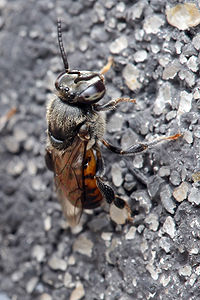
Photo from wikipedia
Native bees contribute a considerable portion of pollination services for endemic as well as introduced plant species. Their decline has been attributed to several human-derived influences including global warming as… Click to show full abstract
Native bees contribute a considerable portion of pollination services for endemic as well as introduced plant species. Their decline has been attributed to several human-derived influences including global warming as well as the reduction, alteration, and loss of bees’ habitat. With human expansion comes along the introduction of exotic plant species with negative impacts over native ecosystems. Anthropic effects may even have a deeper impact on communities adapted to extreme environments, such as high elevation habitats, where abiotic stressors alone are a natural limitation to biodiversity. Among these effects, the introduction of exotic plants and urbanization may have a greater influence on native communities. In this work, we explored such problems, studying the relationship between the landscape and its effect over richness and abundance of native bees from the subandean belt in the Andes mountain chain. Furthermore, we investigated the effects of exotic plant abundance on this high-altitude bee assemblage. Despite the landscape not showing an effect over bee richness and abundance, exotic plants did have a significant influence over the native bee assemblage. The abundance of exotic plants was associated with a relative increase in the proportion of small and medium bee species. Moreover, Halictidae was the only family that appeared to be favored by an increase in the abundance of exotic plant species. We discuss these results and the urgent need for further research of high-altitude environments due to their vulnerability and high endemicity.
Journal Title: PeerJ
Year Published: 2018
Link to full text (if available)
Share on Social Media: Sign Up to like & get
recommendations!